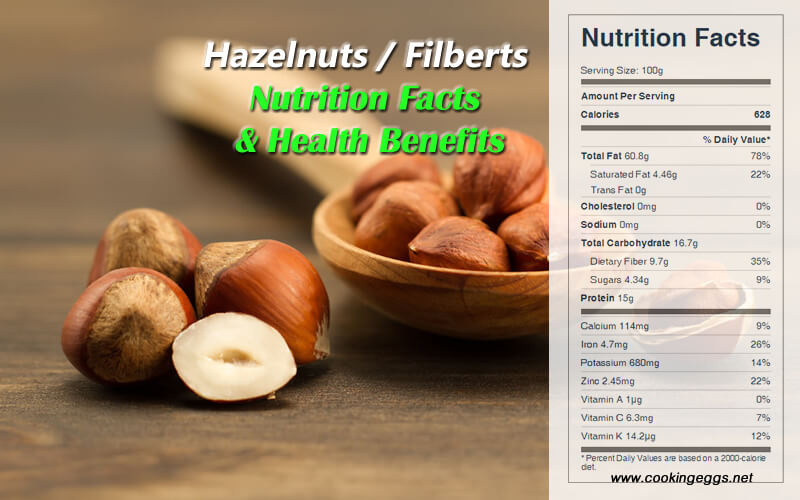Hazelnut (Filbert) Nutrition Facts & Health Benefits
Hazelnuts are members of the hazel family. The wild nut is known as a hazelnut, whereas the cultivated nut is called a filbert. Both are rich in calcium and minerals, are acid-forming, and strengthen teeth and gums.
The nutritional value of hazelnuts
Raw hazelnuts are 5% water, 61% fat, 17% carbohydrates, and 15% protein.
Hazelnuts contain particularly high amounts of protein, dietary fiber, vitamin E, iron, thiamin, phosphorus, manganese, and magnesium, all exceeding 30% DV. Several B vitamins have appreciable content. In lesser but still significant amounts (moderate content, 10–19% DV), are vitamin K, calcium, zinc, and potassium.

One ounce of dry roasted hazelnuts provides 188 calories, 5.1 g carbohydrate, 2.8 g protein, 18.8 g fat, 2 g dietary fiber, 20 IU vitamin A, 21 mcg folic acid, 132 mg potassium, 92 mg phosphorus, 56 mg calcium, and 84 mg magnesium.
Hazelnuts are a significant source of total fat, accounting for 93% DV in a 100-gram amount. The fat components are monounsaturated fat as oleic acid (75% of total), polyunsaturated fat mainly as linoleic acid (13% of total), and saturated fat, mainly as palmitic acid and stearic acid (together, 7% of total).
Raw Hazelnuts Nutrition Facts Label
Health Benefits of Hazelnuts
Deliciously crunchy hazelnuts can be bought ready-shelled to eat as a nourishing snack. They contain the B vitamin thiamine, a deficiency of which can make you feel low and lethargic. They also supply the omega-3 fats needed to balance the omega-6 fats in our diets.
Hazelnuts are high in protein, carbohydrate, fiber, and monounsaturated fat. These are especially rich in vitamin E and provide significant amounts of the B vitamins thiamine, folate, and B6, as well as the minerals iron and phosphorus.
Hazelnuts have great anti-inflammatory properties and a positive effect on cholesterol with their source of monounsaturated fatty acids. The anti-inflammatory benefits come from the composition of nutrients and bioactive substances. Hazelnuts are rich in MUFAs, PUFAs, fibers, alpha-tocopherol, phytosterols, phenolic compounds, magnesium, copper, and selenium.
Of the few studies that assess the effect of hazelnut consumption, the most relevant results are attributed to the ability to upregulate antioxidant enzymes. A pilot study confirmed that after hazelnut consumption, there is an upregulation in two antioxidant enzymes, SOD and CAT. These are the two more important enzymes involved in the antioxidant pathway to catalyze superoxide to oxygen and water.
Even more interesting, the researchers found an upregulation of MIF, a cytokine that can regulate the innate and adaptive immune responses. This is key in reducing inflammation and ensuring our immune system is responding at the right times and not in a chronic inflammatory response state. In addition, it plays a key role in regulating the antioxidant response element as well.
This is an important step to ensure we have the elements needed for redox homeostasis. It’s almost as if MIF is an alarm that goes off when there is oxidative stress, and the ability to upregulate it through the consumption of hazelnuts could be a mechanism to reduce oxidative stress on our cells.
Dry-roast hazelnuts in a hot frying pan, chop them, and sprinkle them on fruit or green salads. They’re a good source of protein and also contain fiber, magnesium, and vitamin E.
Hazelnuts are used in baking and desserts, confectionery to make praline, and also used in combination with chocolate for chocolate truffles and products such as chocolate bars, hazelnut cocoa spread such as Nutella, and Frangelico liqueur. Hazelnut oil, pressed from hazelnuts, is strongly flavored and used as a cooking oil.